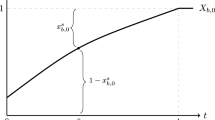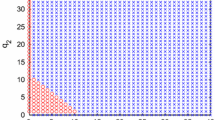Abstract
We consider the problem of dynamic admission control in a Markovian loss queueing system with two classes of jobs with different service rates and random revenues. We establish the existence of an optimal monotone policy. We also show that under certain conditions there exist preferred jobs from either class.
Similar content being viewed by others
References
Altman, E., Jiménez, T. and Koole, G.M. (1998) On optimal call admission control. Technical report WS-503, Department of Mathematics and Computer Science, Vrije Universiteit, Amsterdam.
Carrizosa, E., Conde, E. and Munoz-Marquez, M. (1998) Admission policies in loss queueing models with heterogeneous arrivals.Management Science, 44, 311–320.
Ghoneim, H.A. and Stidham, S. (1985) Control of arrivals to two queues in series. European Journal of Operational Research, 21, 399–409.
Hernandez-Lerma, O. and Lasserre, J.B. (1999) Further Topics on Discrete-Time Markov Control Processes, Springer-Verlag, New York.
Keilson, J. (1970) A simple algorithm for contract acceptance. Opsearch, 7, 157–166.
Ku, C. and Jordan, S. (1997) Access control to two multiserver loss queues in series. IEEE Transactions on Automatic Control, 42, 1017–1023.
Lippman, S.A. (1975) Applying a new device in the optimization of exponential queueing systems. Operations Research, 23, 687–710.
Lippman, S.A. and Ross, S.M. (1971) The streetwalker's dilemma: a job shop model. SIAM Journal of Applied Mathematics, 20, 336–342.
Lippman, S.A. and Stidham, S.M. (1977) Individual versus social optimization in exponential congestion system. Operations Research, 25, 233–247.
Miller, B. (1971) A queuing reward system with several customer classes. Management Science, 16, 234–245.
Miller, B.L. and Buckman, A.G. (1987) Cost allocation and opportunity costs. Management Science, 33, 626–639.
Naor, P. (1969) On the regulation of queue size by levying tolls. Econometrica, 37, 15–24.
Örmeci, E.L. and Burnetas, A. (1999) Admission policies for a two class loss system with batch arrivals. EURANDOM technical report 99-052, Eindhoven, The Netherlands.
Örmeci, E.L., Burnetas, A. and Van der Wal, J. (1999) Admission policies for a two class loss system. EURANDOM technical report 99-050, Eindhoven, The Netherlands.
Puterman, M. (1994) Markov Decision Processes, John Wiley and Sons Inc., New York.
Righter, R. (1994) Scheduling, in Stochastic Orders and their Applications, Shaked, M. and Shanthikumar, J.G. (eds), Academic Press, Boston, MA.
Ross, K.W. (1995) Multiservice Loss Models for Broadband Telecommunication Networks, Springer-Verlag, New York.
Walrand, J. (1988) Introduction to Queueing Networks, Prentice Hall, Englewood Cliffs, NJ.
Xu, S.H. and Shanthikumar, J.G. (1993) Optimal expulsion control-a dual approach to admission control of an ordered-entry system.Operations Research, 41, 1137–1152.
Author information
Authors and Affiliations
Rights and permissions
About this article
Cite this article
Örmeci, E.L., Burnetas, A.N. & Emmons, H. Dynamic policies of admission to a two-class system based on customer offers. IIE Transactions 34, 813–822 (2002). https://doi.org/10.1023/A:1015552906175
Issue Date:
DOI: https://doi.org/10.1023/A:1015552906175




